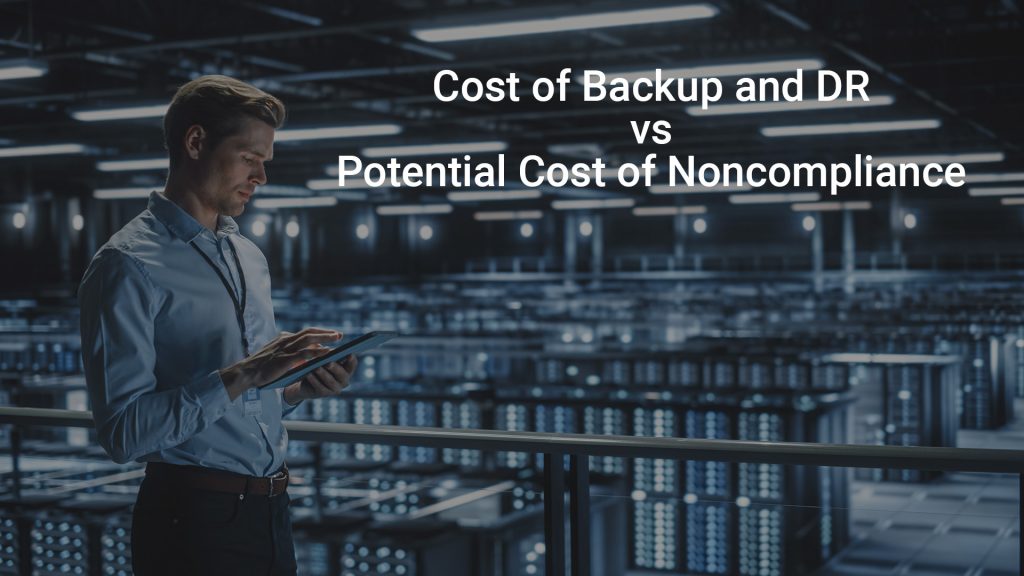In the digital era, every byte of data is valuable. Businesses are building their competitive advantage on a mountain of data, and losing it could be catastrophic.
But, there’s a flip side to this coin. With great data comes great responsibility. The word ‘compliance’ might send shivers down your spine, but it’s an essential part of your backup and disaster recovery (BDR) strategy.
However, the road to balancing compliance and cost isn’t always a smooth one. There are myths to debunk (like the one about backups being enough for disaster recovery) and a number of factors to consider.
Factors to consider
When safeguarding your business data, selecting the right backup and disaster recovery solution is a complex equation involving cost, compliance, frequency, and recovery time. Here’s what you need to know to make an informed decision:
- Cost: The cost of backup and disaster recovery solutions can vary widely depending on the type of solution and the amount of data being backed up. It’s important to balance the cost of the solution with the potential cost of data loss or downtime.
- Compliance: Compliance regulations can vary by industry and location, and failing to comply with these regulations can result in hefty fines and reputational damage. It’s important to ensure that backup and disaster recovery solutions meet any relevant compliance requirements.
- Frequency: The frequency of backups can impact both the cost and the level of protection provided. More frequent backups can provide better protection but can also be more expensive.
- Recovery time: The time it takes to recover data after a disaster can impact business operations and customer satisfaction. It’s important to consider the recovery time when choosing a backup and disaster recovery solution.
Balancing Compliance and Cost in Backup and Disaster Recovery
Businesses need to strike a balance between cost efficiency and risk mitigation when it comes to cloud backups and disaster recovery solutions. Here are 5 ways you can do so without breaking the bank.
- Conduct a cost-benefit analysis: To balance the cost and benefits of different backup and recovery options, conduct a cost-benefit analysis. This analysis should consider factors such as backup frequency, speed, cost, storage space, recovery time, and testing.
- Implement effective data management practices: Effective data management can reduce the volume of data needing backup, consequently lowering costs. This could involve eliminating redundant or outdated data, compressing data, and employing data deduplication techniques.
- Choose a reliable backup and cloud service provider: A more comprehensive backup and recovery solution offers greater security and rapid recovery in the event of a disaster.
- Understand the Shared Responsibility Model: It is important to understand the Shared Responsibility Model, which dictates that businesses are responsible for backing up their data if disruptions or outages lead to data loss. When SaaS providers back up their data, they have the measures in place to recover their entire platforms. However, individual data may be lost, and here, it’s the business’s responsibility to ensure that their data is consistently backed up in the case of such an event.
- Streamline compliance reporting: Backup compliance reporting can help organizations avoid hefty fines and protect data. Streamlining compliance reporting can reduce the time spent on monitoring and enable backup teams to focus on tasks more relevant to their jobs.
A robust BDR strategy that balances cost and compliance is an ongoing commitment to protect the lifeblood of your business: your data. But balancing compliance and cost in backup and disaster recovery can be a tough task for businesses, especially when they have to navigate the labyrinth of regulatory requirements and keep it within budget. However, a cloud service provider can effectively address these two issues.
Final Thoughts
Cloud solutions providers specialize in data management and protection. They stay updated with the latest regulations and standards, ensuring your data is handled in a way that meets all necessary compliance requirements. This not only alleviates the burden of staying updated on ever-changing rules but also mitigates the risk of non-compliance and potential penalties.
A further major advantage of using a cloud solutions provider is cost-effectiveness. With a cloud-based solution, businesses can avoid the high upfront costs of purchasing and maintaining physical servers and other infrastructure. Plus, the subscription model allows for predictable budgeting. Moreover, these providers often include updates and upgrades in their service, ensuring access to the latest technology without extra costs.
By outsourcing backup and disaster recovery to a cloud solutions provider, businesses can free up their internal IT staff to focus on strategic initiatives rather than daily data management tasks. This efficiency can lead to additional cost savings and increased productivity.
Don’t let the complexities of cost and compliance in backup and disaster recovery slow down your business. Contact us, and let’s start building your robust and compliant BDR strategy together.


